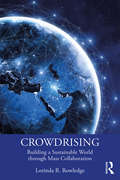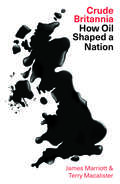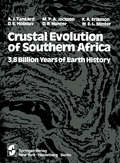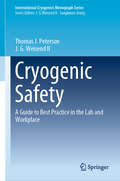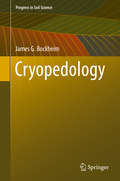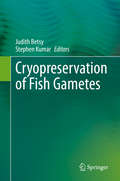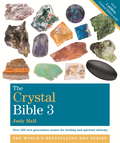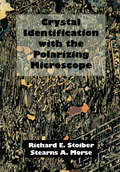- Table View
- List View
Crowdfunding for Environmental Sustainability and the Circular Economy: Empowered Strategies for Sustainable Growth
by Filippo Corsini Marco FreyThis book explores how crowdfunding can effectively promote environmental sustainability and circular economy practices in businesses, emphasizing its role in providing crucial financial resources. The importance of financial resources in businesses represents an essential enabler for implementing and scaling sustainable solutions. The book is composed of six chapters, which analyze some key aspects, such as how crowdfunding has been used to develop circular products, success factors for environmental crowdfunding campaigns, the issue of greenwashing in crowdfunding campaigns. By offering a comprehensive and critical analysis of the main issues at stake, this volume provides valuable insights for scholars and students of sustainable business and green finance. The present work also highlights how crowdfunding can help companies to integrate strategies to improve product environmental performance, engage in environmental marketing, and consider alternative business models. Overall, this book is essential to better understand how innovative funding solutions can overcome financial barriers and foster impactful environmental projects.
CrowdRising: Building a Sustainable World through Mass Collaboration
by Lorinda R. RowledgeOpen innovation enabled through crowdsourcing is one of the hottest topics in management strategy today. Particularly striking – and of vital importance to the world – are the pioneering efforts to apply crowdsourcing technology and open innovation to solve social, environmental, and economic sustainability challenges. CrowdRising sets out these challenges as context and then highlights the experiences of leaders and early adopters, identifies implementation guidelines, critical success factors and lessons learned, and finally projects where the field is going in the future. With a strong focus on the applications of crowdsourcing for innovation, engagement, and market intelligence, the book profiles the initiatives of companies, NGOs, and technology providers using crowdsourcing to develop these solutions to global problems. It addresses the key challenges impacting organizations: 1) identifying more sustainable ways to design, distribute, transport, recycle, and repurpose products; and 2) discovering and implementing the systems needed to transform global economic growth, drive human prosperity, and replenish the planet’s resources.
CrowdRising: Building a Sustainable World through Mass Collaboration
by Lorinda R. RowledgeOpen innovation enabled through crowdsourcing is one of the hottest topics in management strategy today. Particularly striking – and of vital importance to the world – are the pioneering efforts to apply crowdsourcing technology and open innovation to solve social, environmental, and economic sustainability challenges. CrowdRising sets out these challenges as context and then highlights the experiences of leaders and early adopters, identifies implementation guidelines, critical success factors and lessons learned, and finally projects where the field is going in the future. With a strong focus on the applications of crowdsourcing for innovation, engagement, and market intelligence, the book profiles the initiatives of companies, NGOs, and technology providers using crowdsourcing to develop these solutions to global problems. It addresses the key challenges impacting organizations: 1) identifying more sustainable ways to design, distribute, transport, recycle, and repurpose products; and 2) discovering and implementing the systems needed to transform global economic growth, drive human prosperity, and replenish the planet’s resources.
Crowdsourcing Geographic Knowledge: Volunteered Geographic Information (VGI) in Theory and Practice
by Daniel Sui, Sarah Elwood and Michael GoodchildThe phenomenon of volunteered geographic information is part of a profound transformation in how geographic data, information, and knowledge are produced and circulated. By situating volunteered geographic information (VGI) in the context of big-data deluge and the data-intensive inquiry, the 20 chapters in this book explore both the theories and applications of crowdsourcing for geographic knowledge production with three sections focusing on 1). VGI, Public Participation, and Citizen Science; 2). Geographic Knowledge Production and Place Inference; and 3). Emerging Applications and New Challenges. This book argues that future progress in VGI research depends in large part on building strong linkages with diverse geographic scholarship. Contributors of this volume situate VGI research in geography’s core concerns with space and place, and offer several ways of addressing persistent challenges of quality assurance in VGI. This book positions VGI as part of a shift toward hybrid epistemologies, and potentially a fourth paradigm of data-intensive inquiry across the sciences. It also considers the implications of VGI and the exaflood for further time-space compression and new forms, degrees of digital inequality, the renewed importance of geography, and the role of crowdsourcing for geographic knowledge production.
Crude Britannia: How Oil Shaped a Nation
by James Marriott Terry MacalisterTaking the reader on a journey through North East Scotland, Merseyside, South Wales, the Thames Estuary and London, this is the story of Britain’s oil-soaked past, present and future. Travelling the country, the authors discover how the financial power and political muscle of an industry built the culture of a nation from pop music to kitchen appliances, and how companies constructed an empire, extracting the wealth of the world from Iran to Nigeria and Alaska. Today, the tide seems to be going out – Britain’s refineries have been quietly closed, the North Sea oilfields are declining and wind farms are being built in their place. As the country painfully shifts into its new post-industrial role in the shadow of Covid, Brexit and the climate crisis, many believe the age of oil to be over. But is it? Speaking to oil company executives and traders, as well as refinery workers, filmmakers and musicians, activists and politicians, the authors put real people at the heart of a compelling story.
Crude Britannia: How Oil Shaped a Nation
by James Marriott Terry MacalisterTaking the reader on a journey through North East Scotland, Merseyside, South Wales, the Thames Estuary and London, this is the story of Britain’s oil-soaked past, present and future. Travelling the country, the authors discover how the financial power and political muscle of an industry built the culture of a nation from pop music to kitchen appliances, and how companies constructed an empire, extracting the wealth of the world from Iran to Nigeria and Alaska. Today, the tide seems to be going out – Britain’s refineries have been quietly closed, the North Sea oilfields are declining and wind farms are being built in their place. As the country painfully shifts into its new post-industrial role in the shadow of Covid, Brexit and the climate crisis, many believe the age of oil to be over. But is it? Speaking to oil company executives and traders, as well as refinery workers, filmmakers and musicians, activists and politicians, the authors put real people at the heart of a compelling story.
Crust/Mantle Recycling at Convergence Zones (Nato Science Series C: #258)
by Stanley R. Hart Levent GülenThis book consists of a collection of papers presented at the NATO Advanced Research Workshop (ARW) on "Crust/mantle Recycl ing at Convergence Zones," held in Antalya, Turkey, between May 25 to 29, 1987. The workshop was attended by 36 earth scientists from ten countries and 28 papers were presented. Crust/mantle recycling is one of the most fundamental processes in the Earth. The study and understanding of this process requires the consideration of the Earth as a whole system including the atmosphere, the hydrosphere and the core, as well as the crust and the mantle; effective interdisciplinary collaboration is therefore essential to our progress. The Antalya ARW gave us the opportunity to assemble key specialists from relevant branches of the earth sciences and to address our state of knowledge. This ARW proved to be very useful in attaining an interdisciplinary, mutual understanding among specialists from diverse fields such as isotope and trace element geochemistry, mineral physics, theoretical geophysics, seismology, experimental petrology, and structural geology.
Crustal Evolution of Southern Africa: 3.8 Billion Years of Earth History
by A. J. Tankard Martin Martin K. A. Eriksson D. K. Hobday D. R. Hunter W. E. MinterSyntheses of the geology of major areas of the Earth's crust are increasingly needed in order that the features of, and the problems associated with, the secular evolution of the continents can be understood by a wide audience. Southern Africa is fortunate in having a remarkable variety of geological environments developed without many breaks over 3. 8 Ga, and many of the rock groups are household names throughout the geological world. In one respect the geology of Southern Africa is particularly important: cratonization clearly began as early as 3. 0 Ga ago, in contrast to about 2. 5 Ga in most other continental areas such as North America. This book documents very well the remarkable change in tectonic conditions that took place between the Early and Mid-Precambrian; we have here evidence of the very earliest development of rigid lithospheric plates. This book is a tribute to the multitudes of scientists who have worked out the geology of Southern Africa over many years and decades. Whatever their discipline, each provided a step in the construction of this fascinating story of 3. 8 Ga of crustal development. In the book the reader will find a detailed review of the factual data, together with a balanced account of interpretative models without the indulgence of undue speculation. One of its attractions is its multidisciplinary approach which provides a stimulating challenge to the reader.
Crustal Magmatic System Evolution: Anatomy, Architecture, and Physico-Chemical Processes (Geophysical Monograph Series)
by Matteo Masotta Christoph Beier Silvio MolloA comprehensive picture of the architecture of crustal magmatic systems The composition of igneous rocks – their minerals, melts, and fluids – reveals the physical and chemical conditions under which magmas form, evolve, interact, and move from the Earth’s mantle through the crust. These magma dynamics affect processes on the surface including crustal growth and eruptive behaviour of volcanoes. Crustal Magmatic System Evolution: Anatomy, Architecture, and Physico-Chemical Processes uses analytical, experimental, and numerical approaches to explore the diversity of crustal processes from magma differentiation and assimilation to eruption at the surface. Volume highlights include: Physical and chemical parameterization of crustal magmatic systems Experimental, theoretical and modelling approaches targeting crustal magmatic processes Timescales of crustal magmatic processes, including storage, recharge, and ascent through volcanic conduits The American Geophysical Union promotes discovery in Earth and space science for the benefit of humanity. Its publications disseminate scientific knowledge and provide resources for researchers, students, and professionals.
Crustal Magmatic System Evolution: Anatomy, Architecture, and Physico-Chemical Processes (Geophysical Monograph Series)
by Matteo Masotta Christoph Beier Silvio MolloA comprehensive picture of the architecture of crustal magmatic systems The composition of igneous rocks – their minerals, melts, and fluids – reveals the physical and chemical conditions under which magmas form, evolve, interact, and move from the Earth’s mantle through the crust. These magma dynamics affect processes on the surface including crustal growth and eruptive behaviour of volcanoes. Crustal Magmatic System Evolution: Anatomy, Architecture, and Physico-Chemical Processes uses analytical, experimental, and numerical approaches to explore the diversity of crustal processes from magma differentiation and assimilation to eruption at the surface. Volume highlights include: Physical and chemical parameterization of crustal magmatic systems Experimental, theoretical and modelling approaches targeting crustal magmatic processes Timescales of crustal magmatic processes, including storage, recharge, and ascent through volcanic conduits The American Geophysical Union promotes discovery in Earth and space science for the benefit of humanity. Its publications disseminate scientific knowledge and provide resources for researchers, students, and professionals.
Cryogenic Safety: A Guide to Best Practice in the Lab and Workplace (International Cryogenics Monograph Series)
by Thomas J. Peterson J. G. Weisend IIThis book describes the current state of the art in cryogenic safety best practice, helping the reader to work with cryogenic systems and materials safely. It brings together information from previous texts, industrial and laboratory safety polices, and recent research papers. Case studies, example problems, and an extensive list of references are included to add to the utility of the text. It describes the unique safety hazards posed by cryogenics in all its guises, including issues associated with the extreme cold of cryogenics, the flammability of some cryogenic fluids, the displacement of oxygen by inert gases boiling off from cryogenic fluids, and the high pressures that can be formed during the volume expansion that occurs when a cryogenic fluid becomes a room temperature gas. A further chapter considers the challenges arising from the behavior of materials at cryogenic temperatures. Many materials are inappropriate for use in cryogenics and can fail, resulting in hazardous conditions. Despite these hazards, work at cryogenic temperatures can be performed safely. The book also discusses broader safety issues such as hazard analysis, establishment of a safe work culture and lessons learned from cryogenic safety in accelerator labs. This book is designed to be useful to everyone affected by cryogenic hazards regardless of their expertise in cryogenics.
Cryopedology (Progress in Soil Science)
by James G. BockheimThis is the first book solely devoted to Cryopedology, the study of soils of cold regions. The analysis treats Cryosols as a three-part system (active layer, transition layer, permafrost). The book considers soil-forming factors, cryogenic processes, and classification and distribution of Cryosols. Cryosols of the Arctic, Antarctica, and the high mountains are considered in detail. The chapters address cryosols and earth-system science, cryosols in a changing climate, cryosols databases and their use, and management of cryosols. The book is rich in color photographs and highlights the author’s 43 field trips to Antarctica, the Arctic, and alpine areas.
Cryopreservation of Fish Gametes
by Judith Betsy Stephen KumarUnderstanding the reproductive physiology and endocrinology of fishes is essential for captive maturation and seed production in the field of aquaculture. Studying the spermatology of fishes is a comparatively new focus in aquaculture, which has emerged as an important area of fish research over the past two decades. In this regard, the cryopreservation of fish gametes is a crucial aspect. Moreover, energetics studies of gametes have become essential, considering the loss of vigour in the spermatozoa after cryopreservation.The latest development in this context is the cryopreservation of spermatogonial stem cell, which is also covered in the book, along with detailed information on embryo cryopreservation in fishes and crustaceans. The role of cryopreservation in conservation programmes is another important aspect, one that will especially interest biologists.This book addresses central issues in fish gamete cryopreservation and breeding, while also reviewing the history of cryopreservation. Its most unique feature is the breadth of its coverage, from basic information on reproduction in fishes, to such advanced topics as embryo cryopreservation. Chiefly intended as a handy troubleshooting guide, the book represents a valuable resource for research students in related fields.
Cryosols: Permafrost-Affected Soils
by John M. KimbleCryosols – permafrost – occupy a unique part of the earth and have properties greatly different from other soils. They also occur where the greatest impact of global warming is predicted. This is the first book bring together the leading researchers in the area of permafrost soils to produce a review of the geography, cryogenic soil forming processes, ecological processes, classification and use of soils that are affected by permafrost.
The Cryosphere
by Shawn J. MarshallThe cryosphere encompasses the Earth's snow and ice masses. It is a critical part of our planet's climate system, one that is especially at risk from climate change and global warming. The Cryosphere provides an essential introduction to the subject, written by one of the world's leading experts in Earth-system science. In this primer, glaciologist Shawn Marshall introduces readers to the cryosphere and the broader role it plays in our global climate system. After giving a concise overview, he fully explains each component of the cryosphere and how it works--seasonal snow, permafrost, river and lake ice, sea ice, glaciers, ice sheets, and ice shelves. Marshall describes how snow and ice interact with our atmosphere and oceans and how they influence climate, sea level, and ocean circulation. He looks at the cryosphere's role in past ice ages and considers the changing cryosphere's future impact on our landscape, oceans, and climate. Accessible and authoritative, this primer also features a glossary of key terms, suggestions for further reading, explanations of equations, and a discussion of open research questions in the field.
The Cryosphere
by Shawn J. MarshallThe cryosphere encompasses the Earth's snow and ice masses. It is a critical part of our planet's climate system, one that is especially at risk from climate change and global warming. The Cryosphere provides an essential introduction to the subject, written by one of the world's leading experts in Earth-system science. In this primer, glaciologist Shawn Marshall introduces readers to the cryosphere and the broader role it plays in our global climate system. After giving a concise overview, he fully explains each component of the cryosphere and how it works--seasonal snow, permafrost, river and lake ice, sea ice, glaciers, ice sheets, and ice shelves. Marshall describes how snow and ice interact with our atmosphere and oceans and how they influence climate, sea level, and ocean circulation. He looks at the cryosphere's role in past ice ages and considers the changing cryosphere's future impact on our landscape, oceans, and climate. Accessible and authoritative, this primer also features a glossary of key terms, suggestions for further reading, explanations of equations, and a discussion of open research questions in the field.
Cryptic Concrete: A Subterranean Journey Into Cold War Germany (RGS-IBG Book Series)
by Ian KlinkeCryptic Concrete explores bunkered sites in Cold War Germany in order to understand the inner workings of the Cold War state. A scholarly work that suggests a reassessment of the history of geo- and bio-politics Attempts to understand the material architecture that was designed to protect and take life in nuclear war Zooms in on two types of structures - the nuclear bunker and the atomic missile silo Analyzes a broad range of sources through the lens of critical theory and argues for an appreciation of the two subterranean structures’ complementary nature
Cryptic Concrete: A Subterranean Journey Into Cold War Germany (RGS-IBG Book Series)
by Ian KlinkeCryptic Concrete explores bunkered sites in Cold War Germany in order to understand the inner workings of the Cold War state. A scholarly work that suggests a reassessment of the history of geo- and bio-politics Attempts to understand the material architecture that was designed to protect and take life in nuclear war Zooms in on two types of structures - the nuclear bunker and the atomic missile silo Analyzes a broad range of sources through the lens of critical theory and argues for an appreciation of the two subterranean structures’ complementary nature
The Crystal Bible, Volume 3: Godsfield Bibles (Godsfield Bibles)
by Judy HallFeatured in Kindred Spiritmagazine, this third volumeof the best-selling Crystal Bible books presents more than 250 new generation, high-vibration stones for healing and transformation.Included are many new and rare minerals whose esoteric properties are not described elsewhere.This essential guide also includes a section on crystal skulls, crystal beings, Madagascan stones, and how to work with the 'new' chakras, such as the Soul Star and Manifestation chakras, that are stimulated by the powerful crystals featured.Your Crystal Bible Volume 3 includes...Crystal ReferenceCrystal InnovationsCrystal BeingsCrystal StructureHigh Vibration CrystalsExploring Crystal PotentialCrystal SkullsBuilding in StoneThe Madagascar StonesCrystal DirectoryAwakening CrystalsPhysical and Subtle AnatomyChakras AssociationsThe 'New ChakrasHealing GridsMaking a Gem Essence...And Much More!
Crystal Growth from the Melt (Crystals #12)
by Georg Müller1 The content ofthis article is based on a German book version ) which appeared at the end of the year 1986. The author tried to incorporate - as far as possible - new important results published in the last year. But the literature in the field of "convection and inhomogeneities in crystal growth from the melt" has increased so much in the meantime that the reader and the collegues should make allowance for any incompleteness, also in the case that their important contributions have not been cited. This could for example hold for problems related to the Czochralski growth. But especially for this topic the reader may be refered to the forthcoming volume of this series, which contains special contributions on "Surface Tension Driven Flow in Crystal Growth Melts" by D. Schwabe and on "Convection in Czochralski Melts" by M. Mihelcic, W. Uelhoff, H. Wenzl and K. Wingerath. The preparation of this manuscript has been supported by several women whose help is gratefully acknowledged by the autor: Mrs. Gisela Neuner for the type writing, Mrs. Abigail Sanders, Mrs. Fiona Eels and especially Prof. Nancy Haegel for their help in questions of the English language and Mrs. Christa Weber for reading corrections. Also the good cooperation with the Springer Verlag, especially Mrs. Bohlen and with the managing editor of Crystals, Prof. H. C. Freyhardt, who critically read the manuscript, is acknowledged.
Crystal Identification with the Polarizing Microscope
by R.E. Stoiber S.A. MorseSome of the simpler measurements of optical mineralogy are so precise and powerful that they give satisfaction to beginning students. Not long after mastering the strike and dip of rock surfaces with the Brunton compass, many geology students are able to determine precisely the identity of quartz, or the anorthite content of plagioclase, or the magne sium ratio of pyroxene with the polarizing or petrographic microscope, by means of measuring refractive index to better than one part in a thousand. Very little training and almost no theory are needed to achieve these skills. But there inevitably comes a time when theory is needed, either to get on with the art, or simply to reconstruct from first principles what is going on, when rote memory fails. In this book we hope to provide both the rote methods and the theoretical background for practitioners at all levels of experience. We draw from several careers-ours, our colleagues', and our students' -in teaching the subject at various levels of sophistication. Our book is intended to serve the needs of industrial and forensic scientists as well as petrogra phers who deal with rocks. Much of our treatment is based on new research, both in matters of presentation and in the optical determination of minerals and other materials.
Crystal Structure Determination
by Werner MassaA concise introduction to modern crystal structure determination, emphasizing both the crystallographic background and the successive practical steps. In the theoretical sections, more importance is attached to a good understanding, than to a rigorous mathematical treatment. The most important measuring techniques, including the use of modern area detectors, and the methods of data reduction, structure solution and refinement are discussed from a practical point of view. Special emphasis is put on the ability to recognize and avoid possible errors and traps, and to judge the quality of results.
Crystal Structure Determination
by Werner MassaThis textbook gives a concise introduction to modern crystal structure determination, emphasising both its theoretical background and the way it is actually carried out. The theoretical sections are supported by many illustrations, and lay emphasis on a good understanding rather than rigorous mathematics. The most important data collection techniques, and the methods of data reduction, structure solution and refinement are discussed from a practical point of view. Many tips and insights help readers to recognise and avoid possible errors and traps, and to judge the quality of results. The second edition has been considerably updated, especially the chapter on experimental methods, which is now mainly concerned with modern data collection using area-detectors.
Crystallographic Statistics in Chemical Physics: An Approach to Statistical Evaluation of Internuclear Distances in Transition Element Compounds (Inorganic Chemistry Concepts #12)
by Fedor Valach Jan Ondracek Milan MelnikThis book introduces the concept of crystallographic non- rigidity and asymmetry of the transition elements as central atoms organometallic compounds. This intrinsic behavior of central atoms in condensed matter is quantified by applying statistical approach. Averaging of extrinsic factors in crystal structures is tested by using variance analysis. Introductionof the above mentioned concept and applications of variance analysis as an approximation for considering factors influencing properties of central atomin the crystal is original and new.

